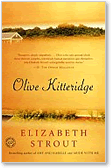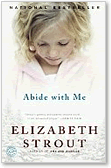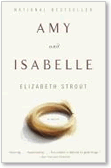Elizabeth Strout
posted Dec 16, 2008
It’s not uncommon for novelists to debut to critical and commercial acclaim, only to see their next novels flame out—or worse, slowly fizzle. Not so Elizabeth Strout, who followed her award-winning first novel, Amy and Isabelle, with a national bestseller, Abide with Me, and whose third book, Olive Kitteridge, has earned strong praise from all corners, ranging from Publisher’s Weekly and the New Yorker to O and Entertainment Weekly. Strout just may be the country’s most unassuming, down-home literary juggernaut.
And down-home she is, hailing from a small New England town much like Crosby, Maine, the setting for Olive Kitteridge. The book is neither novel nor a series of interconnected short stories, but rather a hybrid—one that an April 2008 New York Times review said “manages to combine the sustained, messy investigation of the novel with the flashing insight of the short story.”
So what’s the secret to continuing to work well and deeply? And what does it have to do with blindly arranging objects in a box? Strout recently sat down (virtually) with failbetter’s fiction editor, Caitlin Johnson, to talk about her work, the difference between being a writer and an author, and what her novels say about the changing American experience.
| * * |
On Olive Kitteridge’s cover, in the spot one usually sees “a novel” or “stories,” it’s described as “fiction.” And as a work, it’s a hybrid: a series of loosely connected stories, in each of which the title character figures, sometimes as protagonist or narrator, and occasionally in a blink-and-you-miss-it cameo. Did you set out to write Olive Kitteridge in this form, or did it emerge as your wrote, and if so, how?
Writing Olive Kitteridge in this form was a decision that evolved over time. I wrote the first “Olive” story a number of years ago—the one where she steals her new daughter-in-law’s clothes at the wedding reception—and as I wrote it, I understood that this character, Olive Kitteridge, would someday have a book of her own. What form it would take, at that time, I didn’t know. But as I wrote and sketched more Olive scenes I began to feel that she was such a force to contend with, on the page, and in the lives of those characters who knew her, that it was best to have the story of Olive be episodic in nature. I also felt that the reader needed to have the experience of this character presented—spread out—in a way that would make it most digestible, and that’s when I thought of having stories where Olive would make just a small appearance: palate cleansers, so to speak. And I am always terribly interested in point of view, so to see Olive in tiny glimpses from others in the community allowed the reader to get a fuller picture of her.
What about the order in which the stories are presented—was it hard to determine the progression, or did it suggest itself?
It did occur to me as I wrote these pieces that I would eventually have to arrange them, of course, into the sequence that would make the entire work be most complete. I was aware at times of a vague worry concerning this. But oddly when the time came to make the decision, they just seemed to slip into the order you now find them. It was almost as though there was no “conscious” decision. I don’t mean to imply that the decision was not made by me—it was. I just mean that they fell together very easily once they were all completed. I think, for example, that there was some intuitive feeling on my part in starting off with the story “Pharmacy.” The reader is allowed to ease into the experience of Olive. The focus on Henry in this first story provides an entryway into their world.
Your first novel, Amy and Isabelle, earned a great many accolades; it won the LA Times Art Seidenbaum Award for First Fiction, the Chicago Tribune Heartland Prize, and was a finalist for the PEN/Faulkner Award. Did the attention it received change your perception of your work, or your work habits? Did the attention become a distraction, or did it motivate you to work harder?
The attention that Amy and Isabelle received was something I tried very hard to avoid noticing, which sounds ridiculous. But what I mean by this is that is was overwhelming to have worked for so many years in a rather furtive state; very few people knew that I was, and had been for most of my life, devoted to the business of fiction writing. So when Amy and Isabelle was published, it was, on one hand, hugely gratifying to think that many people were able to respond to the story of this single mother and her teen-aged daughter. On the other hand, it brought great anxieties. Being an author is different from being a writer, and I was not necessarily prepared for some of the public duties required of an author. So the anxiety of that was distracting, yes. It did not change my work habits—I have always worked as steadily and deeply as possible, and this continues to be true.
In the past, you’ve described beginning a novel feeling as though your head is inside a cardboard box that you can’t see out of. How do you find your footing, and what is your process like to work from that place of blindness to seeing the emerging threads of a story?
Actually, the image I have had is that my hand is reaching through a hole into a box. I can’t see into the box, but there are shapes and pieces in there that need the proper arrangement, and I can only keep running my hand over them and trying to get them in the right form. The question of blindness never really leaves; it’s part of the thrill of writing—for me. Certainly there are days when the frustration of this sense is large and unpleasant. But it is something one gets used to, works with. I simply keep going, and mull aspects over in my mind while walking down the sidewalk, or sitting on the subway. And then there are times when a very conscious decision gets made to sit down and see what’s really going on with the manuscript. What is it like for the reader? Can sense be made of what I have there? What needs to be fuller, thinner? I love the sense of shape, and have often thought that in a different life I would work with clay, make sculptures.
How do stories generally come to you: do you tend to begin with characters, a line or image, a sense of the plot?
Stories generally come to me, I think, with some kind of image; it can be the faintest thing, such as the way sunlight falls through a screen porch. Also they may come to me with a character; again, just a glimpse in my mind of someone. It’s often impossible for me to remember, after a story or a novel is finished, where the original “idea” of it came from. Perhaps there is something I remember from long ago, or something I heard years earlier that arrives in my mind and causes me to imagine a person and place. One thing I can say is that stories don’t come to me with any sense of plot. And even when, as I progress, I think I know what will come next, I have learned to be skeptical about that—sometimes I do know, and more often I don’t. What is important is to keep a sense of fluidness as long as possible. This is why I seldom write from beginning to end. I write pieces, and move them around. And the fun of it is watching the truthful parts slide together. What is false won’t fit.
Your prose is at once precise and rich, and one has the sense you revise each page many times, going over each line closely, on every pass. How many drafts do you typically do? Do some of your works “write themselves” quickly, while others take much more time and effort? What do you find the hardest thing to write—descriptions, dialogue, certain types of scenes, certain types of stories—and what’s the easiest?
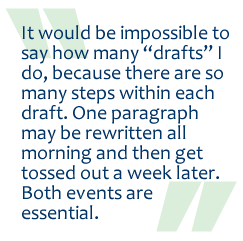
I do revise a great deal. The way I revise is always changing. There are pages that stay the way they were originally written, and there are others that are redone innumerable times. It depends on whether or not I have found the tone that is needed. Sometimes this tone comes to me more naturally than others. It would be impossible to say how many “drafts” I do, because there are so many steps within each draft. One paragraph may be rewritten all morning and then get tossed out a week later. Both events are essential. Because I love the physical world, I am drawn to descriptions of light and weather and the buildings we live in and the roads we drive on. But I also love the way people speak, and so dialogue is a different kind of pleasure. If there is a scene of great emotion I have to be sure I am willing to fall into it fully; it requires a physical exhaustion that one has to allow for. This is really true for all scenes. One can’t be thinking of dry cleaning or errands—it is a dive into a world that has to be quite complete; if I have not experienced it fully, why would the reader do so?
Amy and Isabelle began as a short story. How did you know it needed to become a novel, and what are the main differences for you in writing a story versus a novel? When in the process do you know which form a piece needs to take?
Amy and Isabelle began as a short story because at that time short stories were all I was writing. Only once, years earlier, had I attempted a novel. It was short, and ended up beneath my bed—I have little recollection of it. But otherwise, I only wrote stories. I loved short stories, and still do, and because I came of age during a certain kind of minimalist time in the history of the American short story, I was naturally influenced by that. So it took me a while to realize that I was a novelist and not a minimalist. Two things happened with the beginning of what would become Amy and Isabelle. One was that the story of this mother and daughter got longer and longer, and the other was that my voice and my style were changing. This was unnerving—a very unsettling time that went on for about three years. I wasn’t able to finish a story, any story, and I didn’t know how to write anything else. Finally I accepted that this would be a novel, though the memory of exactly how that acceptance took place eludes me now. But I found the first page, after countless attempts, and settled down to write a book. It is hard for me to say what is different about writing a story and writing a novel. Each requires the same adherence to tautness and tone. The sense of “blindness” that I mentioned earlier is larger with a novel; there is a greater, longer, sense of working in the dark. But stories are not easier, I think.
You’ve said that you work at a kitchen table cluttered with papers and snippets of ideas—do you still? And in general, how has your writing process changed over the years?
It’s been awhile since I’ve had a kitchen table. I write many places: at the dining room table (which is not exactly in a dining room) or on the couch, or in a diner, or at a library. I still work with a tremendous amount of clutter, there is nothing neat or organized about the way I work—not at all. It is a messy business. That’s why I will sometimes take myself to a library—in order to see only the pages that are in front of me. Or in a diner, I may feel free for a few moments to sketch something that has not been fully present to me. But mostly I continue to work at home among my notebooks and drafts and my dictionaries and books. When the table is used for a meal, I clear it off. I can’t bear to have people eat at a table with any papers or pencils on it. (Though if I am alone I will do that.) And then the next morning, the scattered papers arrive right back on the surface. I do actually have a desk now, and yet I find I seldom use it for writing.
If you still write at the table, does your family begrudge you doing so? And where do you eat dinner?
As far as I know, no one begrudges the cluttered table, since it does get cleared off for meals. Where do I eat dinner? It varies, depending on circumstance: who is around, what is happening. My favorite place to eat dinner is at a restaurant, though obviously that’s not something that happens every night. I am not a person who enjoys making meals very often, though I enjoy it when they are made for me.
You grew up in Maine and have made a name by being a master at capturing life in small New England towns. Why write so much about this part of the world, rather than New York, your current hometown?
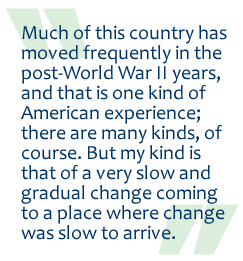
I am writing about the American experience—one part of it. The part where people have a long history related to the land, and how that is in the process of changing. Because I come from many generations—on both sides—of Maine settlers, this is the landscape of my heart. The realization of this came as a surprise to the adult me; growing up, I was very eager to leave the jagged coastline and inland snows. But after spending over twenty years in New York City (a city I love) I have come to recognize more distinctly that there are certain areas of the country, and Maine is one of them, where people identify with the land itself; it is part of who they are. Much of this country has moved frequently in the post-World War II years, and that is one kind of American experience; there are many kinds, of course. But my kind is that of a very slow and gradual change coming to a place where change was slow to arrive. The world of Amy and Isabelle already no longer exists—the mills are closed, most of them, and a single mother raising a daughter would most likely not feel compelled to lie about her own past the way Isabelle Goodrow did. Abide With Me is also an account of what was, and is no longer. While small town ministers continue to exist, Tyler Caskey was a minister who—given his time and place in history—was not expected to speak of anything political from the pulpit. The role of ministers has changed a great deal since then, and I think it’s safe to say that currently religion is going through some desperate spasms in this country, as is our interpretation of the Constitution, and our own sense of what it means to be American. The book Olive Kitteridge reflects this; it has references to religious differences appearing on the coast of Maine—as of course they are, and have been. Also, the fact that Christopher Kitteridge does not stay in town as his parents had expected he would, that the pharmacy is now a huge chain store, that Olive is confused and frightened by her one foray into New York City—all this is a record of what is happening to a part of the Maine population whose Protestant ancestors were Puritans or Scotsmen or other Englishmen. It fascinates me to note the evolution of the original zealotry of this part of our country’s history.
What are you working on now? And what form will your next work take?
I am working on a large novel, and it takes place mostly in New York City, with parts of it taking place in Maine; it also involves the Somali population that has come to live in Maine—a true American story.
© 2008 failbetter LLC · all rights reserved





